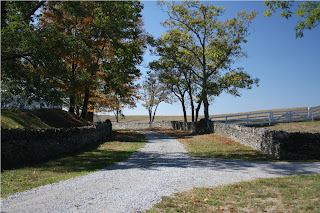We called them "slave fences," having been told that they had been built by slave labor before the Civil War. They're dry-stack stone walls, built without the use of mortar between the stones, and are common in Kentucky's Bluegrass region. There they originally were "clearance walls," built from stones cleared from the fields to make plowing easier. In Kentucky, they date mostly from the nineteenth century, although they have a much older history in Great Britain.
While dry-stack stone walls may come in various designs using different materials elsewhere, in Kentucky they tend to be similar wherever found. The fields of the Bluegrass are underlain by limestone, so that's the stone available. The first several courses are lain flat, wide enough to provide stability. The final course is placed near the vertical, which both increases height and anchors the top. It happens to be esthetically pleasing, as well.
Today the stone walls are mostly decorative. On working farms they tend to be backed by electric fences that do the real work of keeping the stock confined. Often they are in disrepair and additional fencing is essential. But where they are found, there's always a tug to get the camera out and shoot some pictures.




Ah, so familiar to me - Yorkshire is full of them. Wherever they are they're beautiful.
ReplyDeleteWell to be corrected these are not SLAVE walls. Only Scottish, Irish and English immigrants worked to build these walls. If a Black farm hand helped to work on any walls he would have been trained by one of the three above and paid for his time. To date no records show any slaves built these walls. A great book which really talks only about Blue Grass walls history, types of stone etc... the book is called "Rock Fences of the Bluegrass, by Carolyn Murray-Wooley and Karl Raitz. Carolyn Wooley started the Dry Stone Conservancy known as the DSC. Currently her Daughter now runs this non profit organization. I have spent a great deal of time testing and working on these walls at the in Shaker Village Harrodsburg KY. Yes your correct on the wall. Most all walls have a 34" base for the foundation set in earth, then the bottom of the wall starts at 26" wide then at 18" up the ties stones are set. Tie stones are typically one long stone which goes across the wall to tie both sides together. They also help with settling of the wall over time. The wall is a total of 36" height being 14" wide. Before having a vertical single or double cope stones on top of the wall adding another 9"-12". This techniques comes from UK where most walls built were to keep live stock in. Making the total wall 48" h. Most all walls having a 1:6 Batter = For every 6" h the wall comes in 1". More details about Dry Laid Stone Construction can be found on by Blog www.RockinWalls.com Mark J. Thank you for taking the time to share this topic. Keep on Bloggin
ReplyDeleteDidn't the Shakers build many of these?
DeleteBlack Slaves trained by whites built it AND MANY was not PAID…. Some were.
DeleteAfrican Hands Built it
I'm from the Yorkshire Pennines, where I spent 10 years building drystone walls - in sandstone in my area, limestone a bit further north. All we used were a string line and a walling hammer; not even a batter frame - the old wallers told us to 'git thy eye in'.
ReplyDeleteThis comment has been removed by a blog administrator.
ReplyDeleteBuilt by indentured irish masons.
ReplyDeleteYes… long side African enslaved
Delete